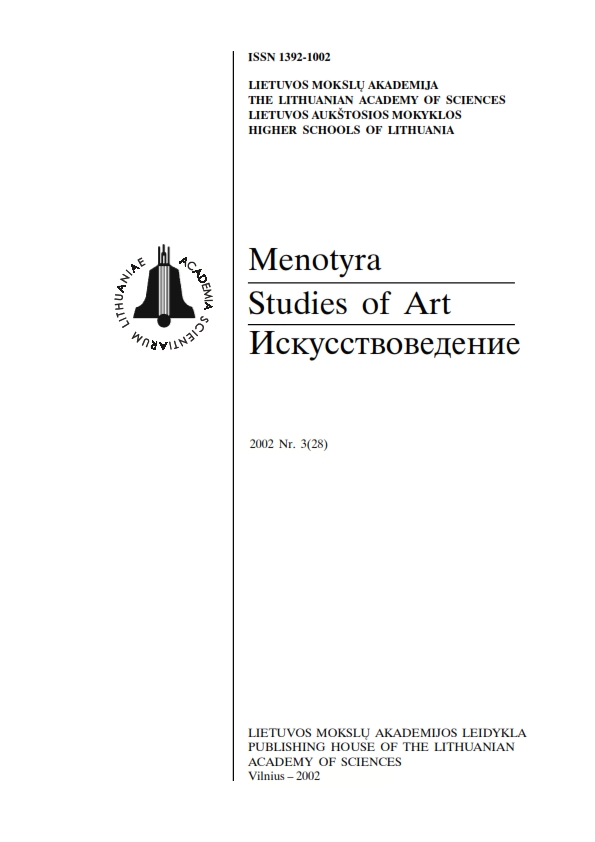Pamiršta hipotezė arba Vilniaus miesto sandara XIV-XV amžiuje
A forgotten hypothesis or the urban structure of the Vilnius city from the 14th to the late 15th century
Author(s): Jūratė MarkevičienėSubject(s): Cultural history, Architecture, Rural and urban sociology
Published by: Lietuvos mokslų akademijos leidykla
Summary/Abstract: The main aim of the article is to represent Marian Morelowsky's study Zarzecze - najstarsze Wilno (Užupis – the Oldest Vilnius) by comparing its notions with the actual data on the subject. The study was created more than sixty years ago and finished approximately in 1939-1940. However, it has never been published and exists as a typescript prepared for publication, archived in the Manuscript Depositary of the Ossolineum Library, Wroclaw (Poland) together with all the other documents of this outstanding pre-war scholar and art historian.The Oldest Vilnius seems to remain completely unknown to researchers, because its ideas have never been discussed or referred to by Lithuanian or even Polish scholars. However, Morelowsky's findings were and still are revolutionary and give quite a different, a non-traditional vision of the urban structure of the oldest Vilnius city: its basic framework, net of communications (streets and distant roads), relationships between the Castle and the City, a defence system of the mediaeval city during the centuries of intense crusades against Lithuania, locations of castles, market squares and the oldest important buildings, etc. Morelowsky claimed that the urban structure of Vilnius developed not in an evolutionary way as it was and still is used to point out. On the contrary, it underwent a revolutionary shift at the beginning of the 16th century, when the City was encircled with a defensive wall. The oldest Vilnius had a linear urban structure, with the main east-west axis, ended with entrance narrows ("necks"), and junctions of the main streets and distant roads on the both sides of such narrows. These narrows were created as defence units for the unwalled medieval Vilnius, and settlements located at these narrows had a defensive structure as well. Entrances and directions of cross-city roads were located differently, if compared to the next ages. The Castle was an isolated defensive unit protected by water, and City ways passed it by, but never crossed. The eastern parts of Vilnius were the oldest ones, tightly related to the third Vilnius Castle, called the Curved Castle. This oldest urban structure has almost disappeared, though its small fragments still are visible in the geomorphologic and urban structures of the 20th century Vilnius. At the beginning of the 16th century the urban structure underwent a radical change: it gained a radiant grid with the main south-north axis which joins the Castle to the City, the old cross-road and streets faded, and the new ones emerged instead, having different directions and locations. This newer structure has survived till nowadays, however, it is a mistake to identify it with the primary original one.A comparative analysis of the above-mentioned notions and findings with the actual publications and non-published research data has shown that in fact many contemporary researchers do not validate their statements on the subject with relevant historic sources and empiric evidences, but merely accept the 19th century (mainly M. Balinsky's) ideas without criticism and testing. On the other hand, empiric evidences from historical, archaeological, architectural stratigraphic, geographic investigations confirm the findings of Morelowsky and not of his opponents. This analysis gives a proof that Morelowsky's notions are very sound and not refutable.All this makes Morelowsky's study a valuable contribution to the studies of the urban history of the oldest Vilnius, and urges to continue them on the basis of a similar integrated and interdisciplinary approach, because a wide coverage of disciplines (history, architectural history, archaeology, geology, geography, etc.) is the best way to analyse the urban structures, though this method seems to have been more widely employed by Morelowsky than by contemporary researchers.
Journal: Menotyra
- Issue Year: 2002
- Issue No: 3(28)
- Page Range: 30-45
- Page Count: 16
- Language: Lithuanian

